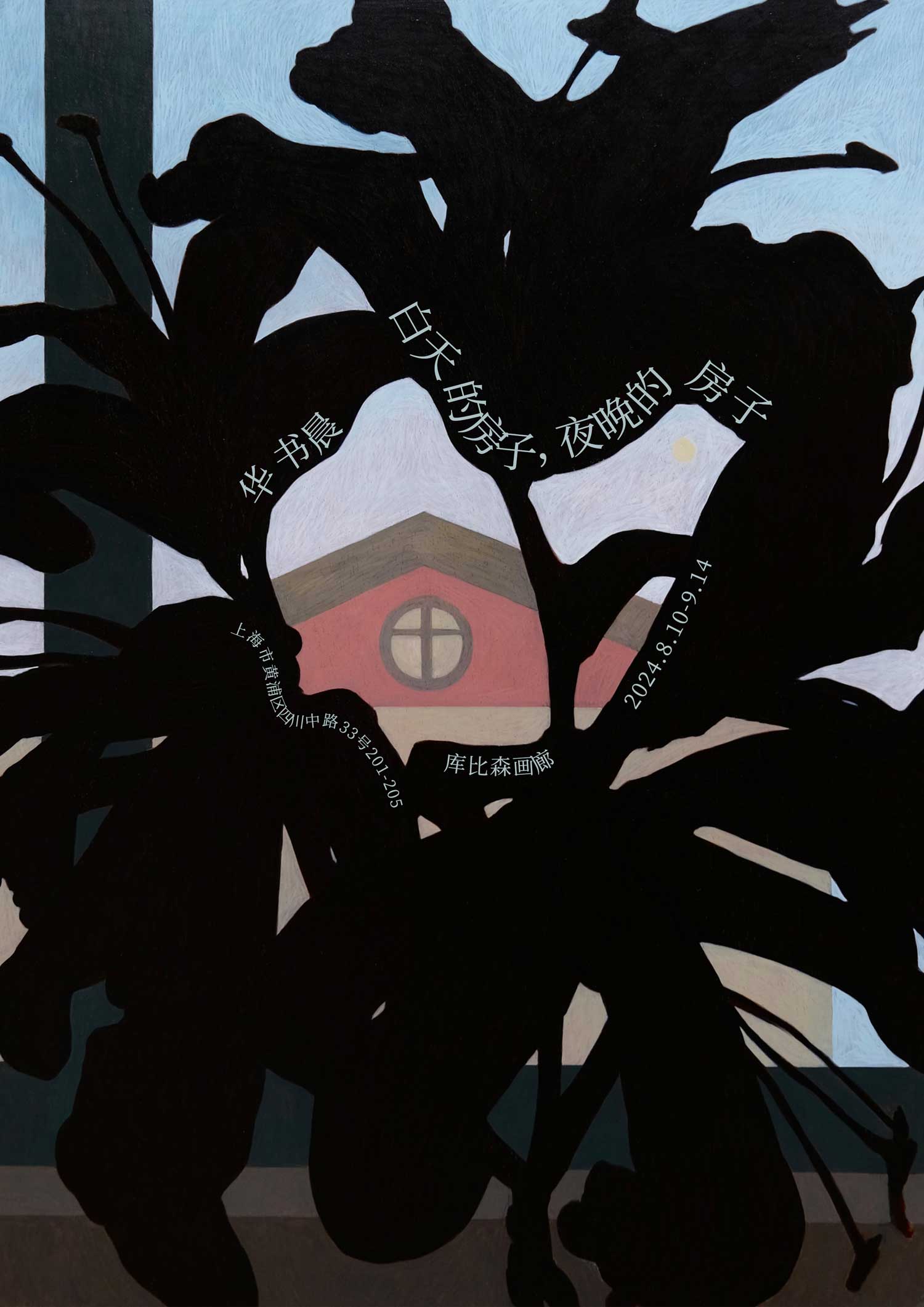展期 Period:
2024.8.10—2024.9.14
艺术家 Artist:
地点 Venue:
前言 Introduction:
展览名取自波兰作家奥尔加·托卡尔丘克(Olga Tokarczuk)的同名小说《白天的房子,夜晚的房子》。艺术家华书晨以“叙述者”(narrator)的视角创作,她试图将某个时刻截留在她的作品中,创造出一个属于她的空房间,并在其中添加故事、图像和经验(已经发生的,正在发生的,还未发生的)。独特的思路让华书晨在保证线性的叙事不被打乱的同时可以多线平行。这也与奥尔加·托卡尔丘克在书中的策略不谋而合:无需出现某个核心情节将所有的故事交织,也没有传统的跌宕起伏的情节以及干净利落的大结局;它们只通过经验、思想、时空、人与事物的重复就联系在一起,每一个问题都自行消解——或者无法解决,视情况而定。
在华书晨的作品中,多视角的叙事将观者带入一场“寻找符号”的事件里:初看无非是一些日常的景观,树、窗户、花盆里的花。但她的创作既是基于对现实的观察,更是基于想象。她重新审视日常景观,将其中不为人们所注意的某种神秘性的和预示性的要素挖掘出来。于是透过风雨来临前孤独屹立的树、绵延不绝包裹着大楼的树、比写字楼更高远的树、一枝独秀于瓶中的百合花、成熟欲坠的花、在窗前拥抱的兰花等等一系列微妙的图像,观众可以从华书晨的作品中看到一个具体而真实的神秘世界。“没有什么生活模式会枯燥得无法用诗意的原则去加以改变,也没有什么物体组合会毫无意义到在它们之间找不出一种有根据的联系。”艺术家将潜意识的意向与生活的感受性片段进行链接,通过“自动书写”的方式,直观地呈现对于物像的真实感受,从而唤醒日常被忽略与压抑的情感与想法。
华书晨画中的窗户象征着时间,它们将画面分成了白天的房子和夜晚的房子。白天的房子是人们清醒时的生活,夜晚的房子则是人们入睡后的梦境。但理应作为主角而出现在房子里的人们却被艺术家有意地隐藏,都不见了踪影。在某种程度上,刻意的隐瞒其实就是一种揭露,就好比蒙住一个人的双眼他反而渴望观看,捂住一个人的嘴巴他却更想呐喊。人伊始于白天的房子,又在夜晚的房子里终结,世世代代的更迭和波澜壮阔的历史不过是这片土地的转瞬即逝的梦。华书晨不是不画人,只是还没有想好应该将人置于何处——所以她就先把人们、把她自己化作了窗外的树影和枝干,化作了窗台前的盆栽,化作了桌上幽幽晃动的烛火,甚至他们化作了灯透过玻璃的光亮。华书晨很早就建立了这样一种信条:艺术作品可以既是简单的,同时也是深刻的,通过白天夜晚的房子内外不断重复出现的日常图像将碎片化的现实生活和梦境连成一片伟大的图景,人们的缺席同时也暗示着他们曾经存在和即将到来,从更广阔的视角出发,华书晨的作品允许确定性和不确定性、已知和未知、稳固与流动的相互平衡,从而构建出一个更宏大的整体。
“我觉得有时候自己不是一个人类,而是洒落在这扇门上、这片土地上的亮光。”
文/Lesilie Dong
The title of the exhibition is taken from the novel of the same name “House of Day, House of Night” by Polish writer Olga Tokarczuk. The artist Hua Shuchen works from a “narrator” perspective, trying to intercept a moment in her work, creating an empty room that belongs to her and to which she adds stories, images and experiences (what has happened, what is happening, what is yet to happen). The unique idea allows Hua Shuchen to have multiple parallel threads while ensuring that the linear narrative is not disrupted. It also coincides with Olga Tokarczuk’s strategy in her book: there is no need for a particular central plot to weave all the stories together, and there are no traditional ups and downs or a clean grand finale; they are linked only through the repetition of experiences, ideas, time and space, people and things, and each problem resolves itself - or unresolved, as the case may be.
In Hua Shuchen’s works, the multi-perspective narrative takes the viewer into an event of “looking for symbols”: at first glance, there is nothing more than everyday landscapes, trees, windows, flowers in pots. But her creation is based not only on the observation of reality, but also on imagination. She re-examines the everyday landscape and unearths the mysterious and prophetic elements that go unnoticed. Thus, through a series of subtle images, such as the tree standing alone before the storm, the tree wrapping around the building endlessly, the tree higher than the office building, the lily standing alone in a vase, the flower ripening and falling, the orchid embracing in front of the window …… the viewer can see a concrete and real mysterious world in Hua Shuchen’s works. “There is no pattern of life so boring that it cannot be changed by poetic principles, and there is no combination of objects so meaningless that it is impossible to find an informed connection between them.” The artist links the subconscious intention with the sensory fragments of life, and through the method of “automatic writing”, visualizes the real feelings of the objects, thus awakening the emotions and thoughts that are neglected and suppressed in the daily life.
The windows in Hua Shuchen’s painting symbolize time, and they divide the picture into house of day and house of night. House of day is the life of people when they are awake, while house of night is the dream of people after they fall asleep. But the people who are supposed to appear in the house as the main characters are intentionally hidden by the artist - they are missing. To a certain extent, the deliberate concealment is actually a kind of revelation, just like blindfolding a person's eyes but he is eager to watch, covering a person’s mouth but he wants to cry out even more. Man begins in house of day and ends in house of night. The vicissitudes of generations and magnificent histories are but fleeting dreams of this land. It's not that Hua Shuchen doesn’t paint people, it’s just that she hasn’t figured out where to put them yet - so she first transforms people and herself into shadows and branches of trees outside the window, the potted plants in front of the window sill, the flickering candles on the table, and even the light of the lamp through the glass. Hua Shuchen has long established on the credo that artworks can be both simple and profound, linking fragmented realities and dreams into one great picture through the recurring daily images inside and outside of the house during the day and night, where people’s absence simultaneously suggests that they were once there and are about to come, from a wider perspective, Hua Shuchen’s works allow for a balance between certainty and uncertainty, the known and the unknown, solidity and fluidity, thus building a larger whole.
“I think sometimes I am not a human, but the light that falls on this gate, on this ground.”
Text by Leslie Dong

